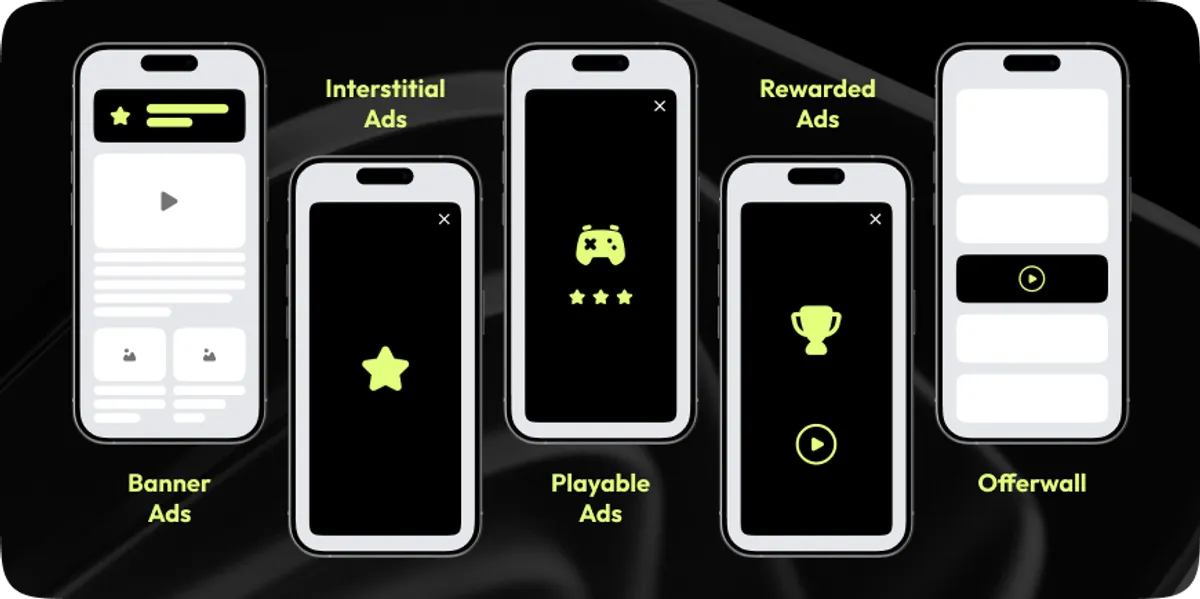In the mobile gaming industry, mobile apps have not only become a vital part of our daily routine but have also turned into one of the main sources of mobile game advertising revenue. The global mobile gaming market is anticipated to generate $105.7 billion in 2025, reflecting a compound annual growth rate (CAGR) of 6.06% from 2025 to 2027. To that end, today's app economy is overwhelmed by free apps, where only a small (~5%) portion of users make in-app purchases and generate revenue. In the US, people spend more than 4 hours on mobile daily. In Argentina, this number is more than 5 hours. And in Indonesia, it exceeds 6 hours. But these numbers are only growing.
Excited to know how much money do mobile games make from ads? Below we'll go through the common ad formats that exist in mobile game advertising, how to measure and optimize your mobile game ads revenue, and more useful advice from TeqBlaze.
If you’re looking to go deeper into effective revenue models, ad formats, and app monetization methods tailored for publishers, check out our full guide on mobile app monetization strategies. It breaks down the pros and cons of each approach and offers insights into how to build a sustainable monetization model from the ground up.
Common types of mobile game advertising

Before investigating how much do mobile games make, let's take a look at the types of ads in mobile games that have a great demand among advertisers and bring maximum profit for publishers.
Interstitial ads
Interstitial is a full-screen ad that pops up while you are using an application between two actions. There are two formats of interstitial ads - video (can be closed at any time) and rich (does not minimize for a certain period). This type of advertising in mobile games is assumed to be one of the most irritating, so use it with caution.
Interstitial ads in the United States typically earn slightly more on Android devices ($10.11) than on iOS ($9.64).
Rewarded video ads
Rewarded video is known as an in-app mobile gaming advertising form where users receive in-game currency after watching an ad. Usually, such videos can be minimized. But in this case, the reward will not be received. So, the audience is forced to finish watching the video. Such ads are less annoying since the user decides to open the ad and can interrupt viewing at any time if desired.
Rewarded video ads are typically considered the most profitable format, earning $10 to $50 per 1,000 views. However, the exact amount depends on the game and ad network.
Banner ads
Banner is one of the typical ad formats in mobile games and apps. For them to bring ad engagement, you need to pay attention to their design and place. This allows you to interest a potential customer in a few seconds. By the way, clickable banners that expand when clicked on have the highest conversion rate.
While banner ads might not be as attention-grabbing, they can consistently remind players about other offers, typically earning $0.10 to $1 per 1,000 views.
Playable ads
Playable ads are mini-games that are most often a demo version of the main game. The user is asked to follow simple instructions while watching the ad. The most interested ones will be joining the gameplay to pass the time and wait for the commercial to end. At some point, tapping on the screen opens the app's download page in the Google Play or AppStore store.
Playable ads can bring from $20 to $100 or more per 1,000 views due to their engaging nature.
Offerwall
Offerwall is a page with a list of rewards. The user can choose the offer, which may include lives, in-game currency, specific coins, etc. This type of advertisement has a high level of ad engagement as it is completely initiated by the user. Offerwalls are the top earners among ad formats, generating eCPMs between $240 and $1,670 on Android, depending on the app category.
Essential metrics for evaluating mobile game ads revenue
Knowing how much do mobile game ads pay is only the tip of the iceberg. If campaigns are not measured correctly, marketers have no idea which channels or creatives are bringing in valuable users. Furthermore, they equally have no clue which campaigns need to be optimized.
The success of an in-app campaign lies in the right ad network, reaching the correct target audience, and the accuracy of your creatives and ad appeal. If even one of these parameters is unsuccessful, the campaign will likely fail to deliver on its promise.
However, by measuring each element separately, you can detect flaws and correct them.
eCPM
Effective Cost Per Thousand Impressions is a fundamental metric that measures the revenue made from ad impressions. It shows how much a developer earns for every 1000 ad impressions on their app.
eCPM = (Total ad revenue / Number of ad impressions) * 1000
eCPC
Effective Cost Per Click shows how much it costs per click on an ad. This indicator helps to evaluate the effectiveness of an advertising campaign and optimize advertising costs.
eCPC = Total ad spend / Number of clicks
eCPA
Effective Cost Per Action measures the cost of a specific targeted user action, such as installing an app or making a purchase. This metric measures the effectiveness of advertising campaigns in achieving specific goals.
eCPA = Total Ad Spend / Number of Targeted Actions
Key factors affecting ad revenue in mobile games
Understanding the key factors affecting mobile game advertising revenue is one of the most important aspects of mobile game ad monetization. Optimizing an advertising strategy requires careful analysis of various parameters, from the frequency of ad impressions to the geographical location of the audience.
Ad frequency
The frequency of ad display is a delicate balance between monetization and user experience. Too frequent ads can irritate users and lead to audience churn, limiting potential revenue. The optimal frequency depends on many factors, including ad format, game theme, and target audience characteristics. Some advertising platforms offer adaptive ad frequency tools that automatically adjust the number of impressions based on user behavior.
User engagement rates and player retention
Player retention and ad engagement are key factors for increasing ad revenue in mobile games. The longer a user spends in the game, the more ads they see. To increase player retention, you need to create quality content, update the game regularly, and add new levels and features. Social elements such as ratings, achievements, and the ability to compete with friends also increase player engagement. Try to personalize the gameplay to each user's preferences to increase the likelihood of retention.
Geographic location
The geographic location of players plays an important role in monetization. The cost of display advertising can vary significantly from region to region. For example, countries with high purchasing power tend to offer higher display rates. Targeting ads to specific geographic regions allows you to optimize ad spend and increase ad effectiveness.
Seasonality
Seasonality and other special events have a significant impact on mobile game advertising revenue. In the run-up to holidays and seasonal events, there is an increase in user activity, which creates additional monetization opportunities. Consider organizing time-limited events and contests to attract new users and increase engagement with existing ones.
Partnerships
Partnering with other companies for joint promotions can lead to a significant increase in mobile game ads revenue. In addition, factors such as user device, time of day, demographics, and ad format affect ad revenue in mobile games. Data analysis, including tracking key metrics (CTR, CR, LTV), A/B testing, and conversion attribution, allows you to evaluate the effectiveness of your campaigns, make necessary adjustments, or decide if you need to find other partners. It is important to gather these analytics regularly to find the best partners and, thus, the best places to advertise online.
How to optimize ad revenue in mobile games
You have now got the types of advertising and how much do games make from ads. Let's move on to practical tips on how to maximize advertising revenue in mobile games without ruining the gameplay.
Importance of ad placement and timing
To start with, your ads should be unnoticeable and benefit the player. Show ads between levels or in pauses, not during the most interesting moments. After an unsuccessful attempt to complete a level, offer the player to watch the video ad for a reward. Also, don't overload the player with ads. Limit the number of impressions in a certain period.
Balancing in-app purchases with ad displays
To keep players happy, it's important to find a balance between free play with ads and paid in-app purchases. Give players the choice to either watch ads and play for free or buy access to all features without ads. Show players ads that interest them. This way, they will be less annoyed. Reward players for watching ads with in-game currency or bonuses. This will make the ads more attractive.
Encouraging repeat gameplay to increase ad views
To keep players coming back to the game more often and seeing more ads, try rewarding them for daily logins with small gifts. You can also organize temporary events with exclusive rewards. Add elements of competition and cooperation with other players. Also, don't forget to update the game regularly so that players don't get bored. The more often players enter the game, the more ads they see, which means more revenue for you.
Trends in mobile game advertising
Mobile advertising continues to evolve with the advent of technology. That is why ad agencies and brands need to understand current trends and capitalize on them to stay competitive.
Personalization and targeting
Personalization is becoming a key element of successful advertising campaigns. Using data on user behavior allows you to create customized ads that resonate better with your audience. At the same time, targeting by interest, location, and demographics helps achieve the greatest effectiveness.
AR and VR advertising
The integration of Augmented Reality and Virtual Reality into mobile gaming opens up new avenues for innovative and engaging advertising experiences. These technologies offer a more immersive and interactive way for advertisers to reach players and promote their products or services. For example, a game could display product information or offer interactive minigames. Gamified advertising is also possible, where advertisers can create challenges, rewards, or mini-games tied to specific brands.
Reward-based advertising
Reward-based advertising is one of the best ways for advertisers to promote their content. This format implies a reward for viewing—a bonus inside the application. Video for reward is most often used in gaming applications when skills are given in the game format.
Voice search
Recently, the use of voice assistants like Siri and Google Assistant has increased, and so has the importance of voice advertising. Optimizing for voice search and creating content tailored to voice commands is evolving into an important part of mobile advertising strategies. These browser searches take into account SEO optimization rules and demonstrate results that the system contemplates as relevant.
Privacy-focused advertising
As privacy concerns are growing at skyrocketing speed, advertisers continue to adapt their strategies to comply with new regulations, such as GDPR and CCPA. This includes focusing on consent-based advertising and using anonymized data.
Learn more about TeqBlaze's expertise
Now that you are aware of how much do game apps make, you may be thinking about saving your time and resources. Trust the development and maintenance of your ad network from scratch to a reliable partner. TeqBlaze stands out as a leading provider of a full spectrum of ad tech solutions suitable for mobile app advertising. You can integrate our white-label SSP+ad exchange platform seamlessly with your existing mobile app development frameworks and ad networks. We also allow you to deliver highly targeted ads to your ideal audience segments for maximum ROI.
One of the prominent examples is a trusted digital ads traffic monetization partner who manages monetization for over 40 mobile publishers integrated via Google SDK. Seeking a solution that could enhance their ad monetization capabilities and provide greater control over their ad inventory, the client partnered with TeqBlaze. TeqBlaze's white-label SSP+Ad Exchange offered a comprehensive suite of features to optimize mobile game ads revenue and improve the user experience, including a custom SDK for direct mobile publisher integration.
By benefiting from granular audience segmentation based on demographics, interests, and behaviors, the client managed to deliver highly relevant ads to their users, enhancing click-through rates and conversion rates. Real-time bidding was another essential feature enabled by TeqBlaze's platform that allowed the client to optimize their yield. The client also implemented header bidding, increasing competition for ad impressions, driving up prices, and improving mobile game advertising revenue. As a result, the client achieved significant improvements in their ad monetization efforts, demonstrating the effectiveness of TeqBlaze's platform for the programmatic advertising landscape and driving revenue growth.
Conclusions
The secret to the success of mobile game advertising lies in the harmony and naturalness of the ad display. In addition, it can be placed at the most appropriate moments of user interaction with the application. Advertising in apps will take your product to a whole new level, but defining goals, a clear marketing strategy, and a comprehensive promotion approach are necessary for success.
TeqBlaze will help you choose optimal monetization strategies, increase visibility in app stores, and engage your target audience.
Book a demo and ensure the success of your app by maximizing its revenue.

 Anna Vintsevska
Anna Vintsevska





